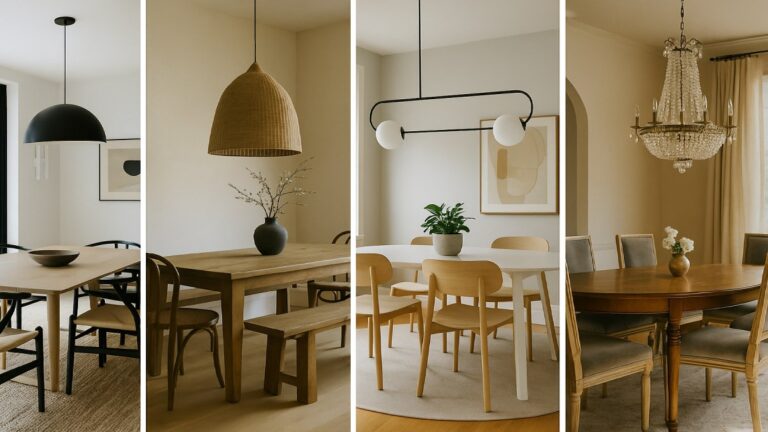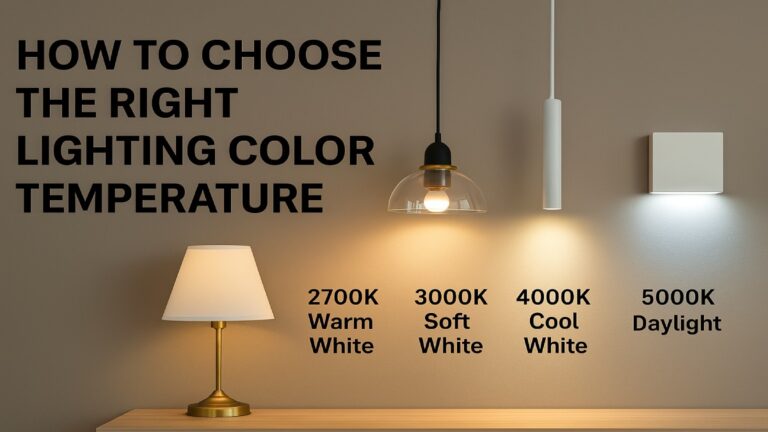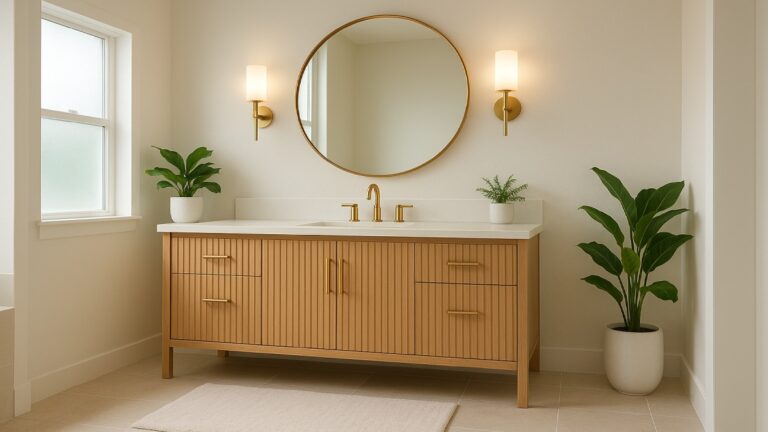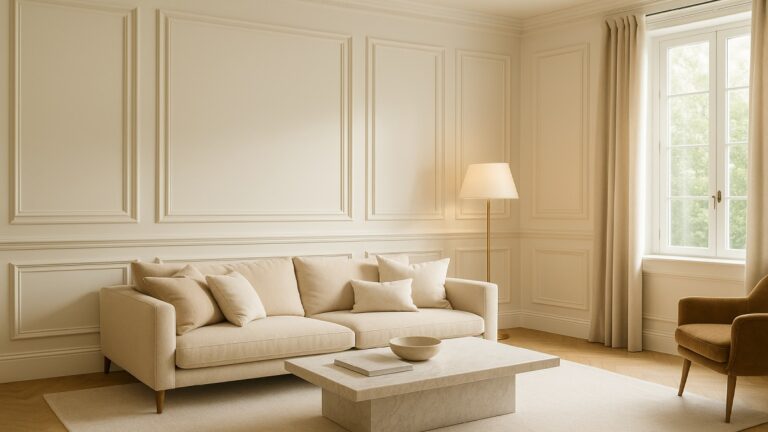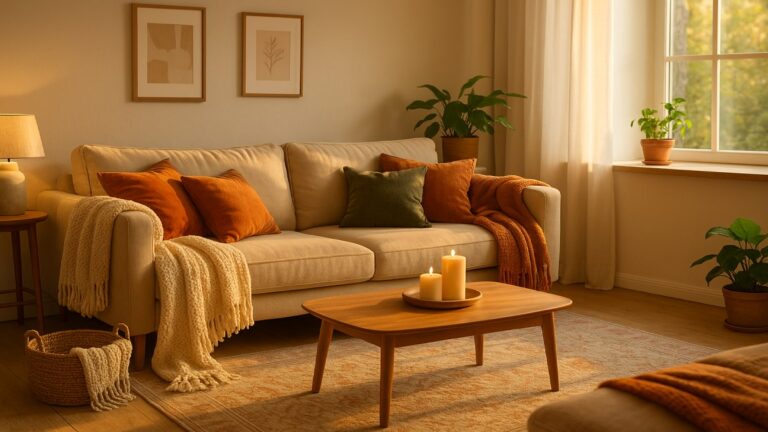How to Choose the Right Rug Size for Every Room in Your Home
Choosing the right rug size can completely transform a room. The right rug grounds your furniture, defines the layout, and brings warmth and comfort to your home. Yet, getting the size wrong is one of the most common decorating mistakes — too small, and your room feels disjointed; too large, and it overwhelms the space. This guide will help you confidently select the perfect rug size for every room in your home, ensuring both balance and beauty.
Whether you’re decorating a cozy apartment or a large open-plan living area, this step-by-step guide covers proportions, measuring tips, placement rules, and common size charts for living rooms, dining rooms, bedrooms, and beyond. You’ll also discover helpful visual tricks designers use to make rooms feel bigger, unified, and more inviting — all simply through smart rug sizing.

Why Rug Size Matters So Much
Rugs are more than decorative pieces — they define zones, create cohesion, and set the tone of the entire space. An undersized rug can make a room appear smaller and disconnected, while a correctly sized rug visually expands and grounds it. Designers often say: “If you think the rug might be too big, it’s probably just right.”
Beyond aesthetics, the right size also affects function. A rug that extends beneath furniture prevents slipping, reduces wear on flooring, and helps distribute weight evenly. For open spaces, rugs also act as invisible walls, separating living, dining, and work areas without physical barriers.
General Rules of Thumb for Rug Placement
- Leave 12–18 inches of visible floor between the rug edge and walls for a balanced border.
- Anchor key furniture pieces — at least the front legs should rest on the rug.
- Size up if you’re between rug dimensions; slightly larger looks intentional and luxurious.
- Use painter’s tape to outline the rug’s footprint before buying — this trick helps visualize proportions accurately.
Keep in mind that different rooms require different approaches. What works in a living room won’t suit a dining area or hallway. Let’s explore room-by-room strategies that take the guesswork out of rug shopping.
Living Room Rug Size Guide
The living room is where rug sizing mistakes happen most frequently. A common issue is buying a rug that’s just big enough for the coffee table, leaving furniture floating around it. The solution? Always aim for a rug that visually unites all seating pieces.
1. All Legs on the Rug
Ideal for large or open-concept spaces, this layout creates a cohesive, grounded look. Every furniture leg sits on the rug, forming a unified zone. Standard sizes: 9×12 or 10×14. Allow at least 8–12 inches of rug extending past the sofa arms for visual breathing room.
2. Front Legs on the Rug
This is the most versatile setup for medium-sized living rooms. Place the front legs of sofas and chairs on the rug, while back legs remain off. It connects furniture without requiring a massive rug. Common sizes: 8×10 or 6×9.
3. Accent or Layered Look
For small living rooms or apartments, layering rugs adds texture and depth. Use a smaller patterned rug (like 5×7) over a large neutral jute or sisal base rug. The larger layer provides scale while the top rug adds personality and warmth.

Dining Room Rug Size Guide
In the dining room, comfort and function go hand in hand. The biggest rule: make sure chairs stay on the rug, even when pulled out. Nothing disrupts a dinner like catching a chair leg on a rug edge.
Perfect Size Formula
Measure your dining table, then add at least 24 inches on all sides. This ensures enough space for chairs to slide easily. For example:
- Table for 4: 6×9 rug
- Table for 6: 8×10 rug
- Table for 8–10: 9×12 rug
Round tables pair best with round rugs — they echo the shape and feel visually centered. If you have an extendable dining table, choose a rug size that accommodates its longest length.
Material & Maintenance Tips
Since spills are inevitable, go for low-pile or flatweave rugs that are easy to clean. Wool is naturally stain-resistant, while synthetic fibers like polypropylene are budget-friendly and practical. Avoid high-pile or shag rugs under dining tables.
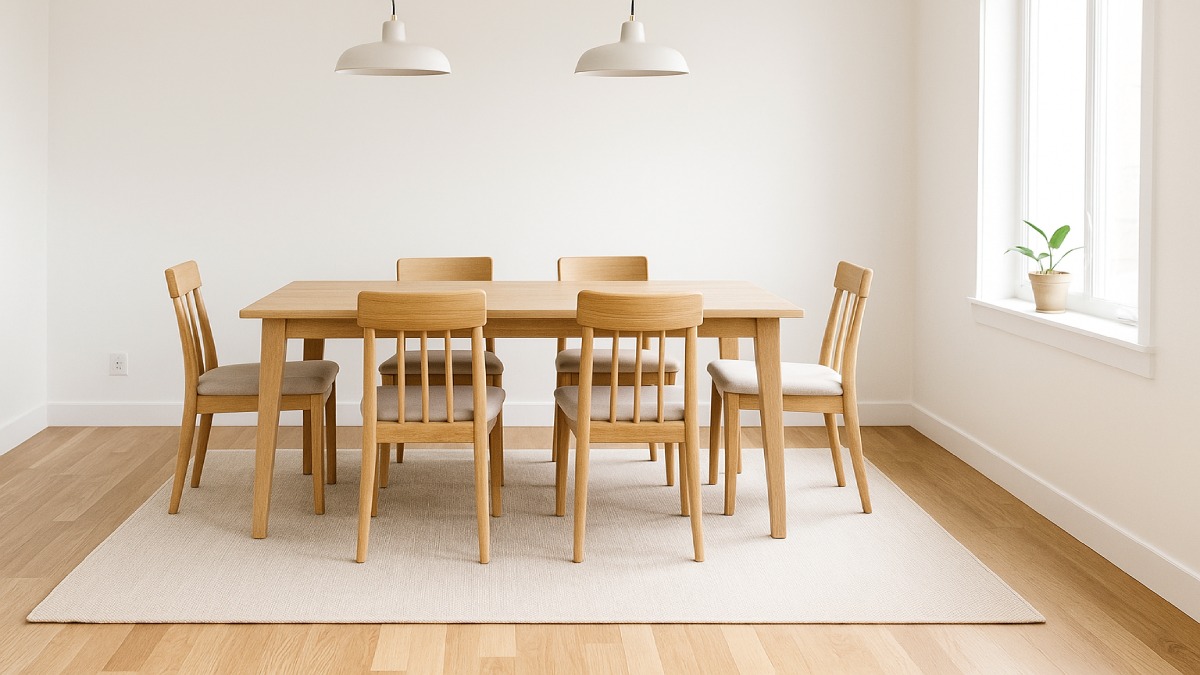
Bedroom Rug Size Guide
The bedroom rug’s purpose is to add comfort and harmony. Since the bed is the dominant element, placement revolves around it. The goal is to step onto softness every morning instead of a cold floor.
King Bed Setup
A 9×12 rug offers generous coverage, fitting beneath the bed and nightstands, and extending well beyond the foot of the bed. This gives a luxury hotel feel and works best in large rooms.
Queen Bed Setup
An 8×10 rug is the perfect balance for queen-size beds. Position it so the rug begins just under the nightstands and extends 18–24 inches on both sides.
Small Bedrooms
When space is tight, use two runners on either side of the bed or a smaller rug placed horizontally at the foot. This still adds softness and structure without crowding the room.
Other Spaces That Benefit from Rugs
Hallways
Runners are ideal for hallways. Leave 3–6 inches of bare floor on each side for a centered appearance. For long hallways, consider multiple runners with consistent spacing.
Entryways
Entry rugs must balance practicality and style. Opt for low-pile rugs with non-slip backing. Sizes like 3×5 or 4×6 work well to define the space while catching dirt before it spreads.
Kitchens
Place washable runners along high-traffic zones such as the sink or stove. Materials like PET, nylon, or cotton are durable and easy to clean. Rug pads add extra comfort when standing for long periods.
Rug Materials and Textures
Different rug materials influence comfort, durability, and maintenance. Wool remains the designer favorite for its natural softness, resilience, and resistance to stains. Cotton rugs are lightweight and washable, ideal for casual spaces. Synthetic rugs like polyester and polypropylene resist moisture and are perfect for homes with kids or pets.
For texture and depth, mix materials. Jute and sisal add earthy warmth but are less suited for damp areas. Layering a soft wool rug over a jute base creates visual contrast and comfort — a common designer trick for large open spaces.

Quick Reference Rug Size Chart
| Room | Ideal Rug Sizes | Placement Notes |
|---|---|---|
| Living Room | 8×10, 9×12, 10×14 | Anchor all or front legs; leave 12–18″ from walls. |
| Dining Room | 8×10, 9×12 | Extend rug 24″ past table edges for chair movement. |
| Bedroom (Queen) | 8×10 | Place two-thirds under bed; leave rug visible on sides. |
| Bedroom (King) | 9×12 | Cover entire bed and nightstands for a luxury feel. |
| Hallway | 2.5×8, 3×10 | Keep equal margins along both sides of the runner. |
| Entryway | 3×5, 4×6 | Ensure clearance for door swings. |
Common Mistakes to Avoid
- Rugs too small: It’s the #1 design mistake. Always size up.
- Ignoring furniture scale: Match rug size to furniture group, not the room.
- Skipping rug pads: Pads prevent slipping and extend rug life.
- Wrong shape: Round rugs complement round furniture; rectangles fit rectangles.
Final Takeaway
Choosing the right rug size isn’t just about measurements — it’s about proportion, harmony, and the way a space feels. Start by measuring your main furniture pieces, outline the dimensions with painter’s tape, and always err on the side of slightly larger. Keep furniture anchored, maintain consistent borders, and select materials that suit your lifestyle.
Once you’ve found the correct rug size, you’ll notice an instant transformation. Rooms feel grounded, balanced, and welcoming — exactly what every home deserves.

